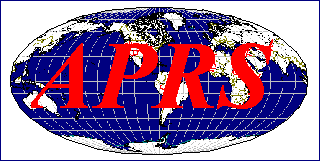 APRS Meteor Scatter Tests
APRS Meteor Scatter Tests

 APRS Meteor Scatter Tests
APRS Meteor Scatter Tests

Updated 10 Sep 2007 (Previous update 1999)
The self plotting of APRS packets and global connectivity of
the APRS-Internet System (APRS-IS) makes it ideal
for casual Meteor Scatter communications experiments. This page suggests
four ideas for experiments with Meteor Scatter comunications:
Monitoring APRS for Meteor Packets: . Anyone in a relatively rural area can easily just monitor APRS any night, and especially during meteor showers to see what kind of packets can be heard. APRS has the advantage of dozens of packets beging transmitted every second from all over the USA on the same frequency. Any of these are potential Meteor bounce packets, but only if the listener is in a quiet location. But this is quite possible in most non-city areas. Before we get into the details of how to monitor for Meteors on 144.39 in the USA, first some facts:
Monitoring Meteor Packets: . You must use a beam.
If you live in a quiet area, where your digi is only busy say 20% of the time, then your station can still hear possible meteor packets for 80% of the time! Just point your beam towards a HIGH density APRS area between 500 to 1000 miles away. Clear your APRS memories and buffers and go to sleep. Next morning see what you got?
Meteor Shower Special Events: . Since meteor showers only last one night and are very predictable, it is easy to further improve your chances of hearing packets by asking the local DIGI sysop to change the settings for one night. These "meteor-event" digi settings will still allow local digipeating of all packets and all visitors, but will reduce the number of packets coming in from out of area. This way, APRS continues to perform locally, but the amount of channel loading goes down by a factor of TEN or more!
For the night of a meteor shower, (Persides, Leonids, or Geminids, (August, November and December), simply ask the local DIGI sysop to change UITRACE from "WIDE" to OFF and make sure that the UIDIGI LIST contains WIDE1-1, WIDE2-1, WIDE2-2, and WIDE3-3. This will quiet the channel drastically in rural areas. Point your beam, and see what you capture by the next morning. It might also be useful to post an APRS bulletin the week in advance on the local channel announcing something like "APRS digipeating reduced to local hops only on 12 August"...
Meteor Shower Results in 1995
The rest of this page is historical. APRSdos has a fully automatic Meteor scatter communications mode, but it was not implemented by any other authors that I konw of. It is not appropriate to use the special MeteorScatter mode on 144.39 but only on dedicaed frequenceis such as 147.585 maybe, if agreed in advance. This is why meteor packet capture on 144.39 as described above has been developed to make it more routine and where all the action already is.
During the 1998 Leonids we saw good APRS packet meteor scatter propogation. Please read METEOR.TXT which tells you all about using APRS or just a TNC for MScatter. The map below shows the results of the 1995 Perseids Meteor Scatter APRS tests.
| zooms up/down (you may also use PGup/dn) | |
| List stations, Show Status or Messages to Java console | |
| Centers or Zooms map on clicked location | |
| scrolls map |
You are visitor number since 14 Nov 1999. This site recorded 17,401 hits from April 98 to Nov 99.
Return to the APRS HOMEPAGE